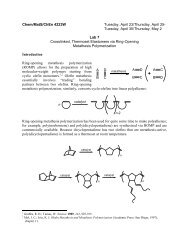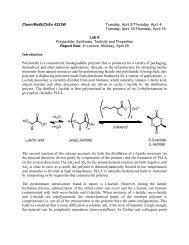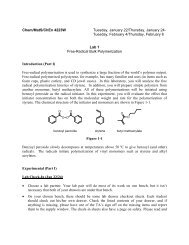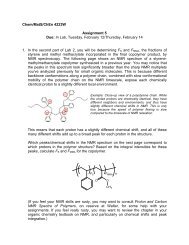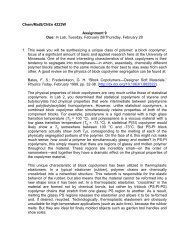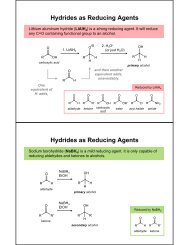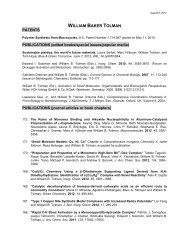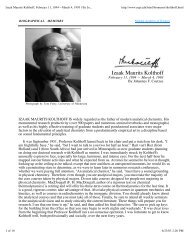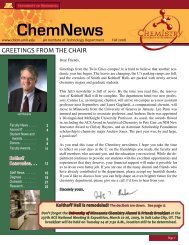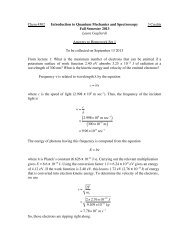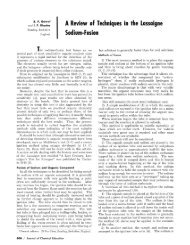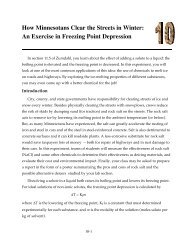Chem/MatS/ChEn 4223W Tuesday, February 26/Thursday, February ...
Chem/MatS/ChEn 4223W Tuesday, February 26/Thursday, February ...
Chem/MatS/ChEn 4223W Tuesday, February 26/Thursday, February ...
You also want an ePaper? Increase the reach of your titles
YUMPU automatically turns print PDFs into web optimized ePapers that Google loves.
Polymer Recovery (Feb <strong>26</strong>/28)Slowly pour the contents of each flask into separate beakers containing 200 mL methanolwhile actively stirring. (Please keep track of which sample was emptied into which beaker!)Your polymer material should precipitate from solution. If it doesn’t, you may want to coolthe solution in an ice bath, add more methanol, or (last resort) add some drops of water. Beaton the polymer glob in each test tube/beaker with a stir rod until the glob stiffens. It may lookas though you’ve achieved liquid phase separation rather than precipitation. If this is so, it’slikely that your top layer will be a mixture of methanol and cyclohexane, and that yourbottom layer is a mixture of polymer and cyclohexane. To draw more cyclohexane out of thepolymer, carefully decant off the methanol-cyclohexane mixture, and add fresh methanol.Keep doing this until you get solid material.Smell your material—likely, it still contains some cyclohexane. Cyclohexane has a highboiling point, so it’s difficult to remove in the vacuum oven, and you should remove it by reprecipitationif possible. Re-dissolve your solid polymer in a minimum amount of methylethyl ketone (< 20 mL). Then re-precipitate this solution into methanol as you did above.Remove the coagulated polymer from each beaker, and discard the methanol solution into thewaste containers.With your stir rod or spatula, try to squeeze as much residual solvent out of each polymer aspossible. Get two PTFE baggies from the hood and tare them. Put each polymer glob into itsown baggie, but each baggie (mouth up) into a beaker marked with your group number/name,and dry your samples in the vacuum oven.Yield Determination (Mar 5/7)After the polymers are dry, weigh each baggie and calculate your yield. You can keep thepolymer in your baggie for now, but try not to scratch or damage the baggie—they cost ~$3 apiece, and we will be trying to re-use them.NMR of PS and PS-PI: Endgroup determination and PI regiochemistry (Mar 5/7)Check out two NMR tubes from the stockroom.Follow the instructions from Lab 2 for preparing NMR samples of your two polymerproducts in CDCl 3 ; dissolve 25 mg of each material in 1 mL of CDCl 3 in separate vials, andtransfer each to an NMR tube. Submit these samples to the TA.As before, your data will appear in the NMR “Data” directory, under the filename posted onthe course Data website.GPC of PS and PS-PI (scheduled by lab pair; Mar 5/7 or Mar 12/14)Follow the instructions from Lab 3 for performing GPC on your two polymer products.Because your materials will be more monodisperse in this lab than in Lab 3, your GPC peak



